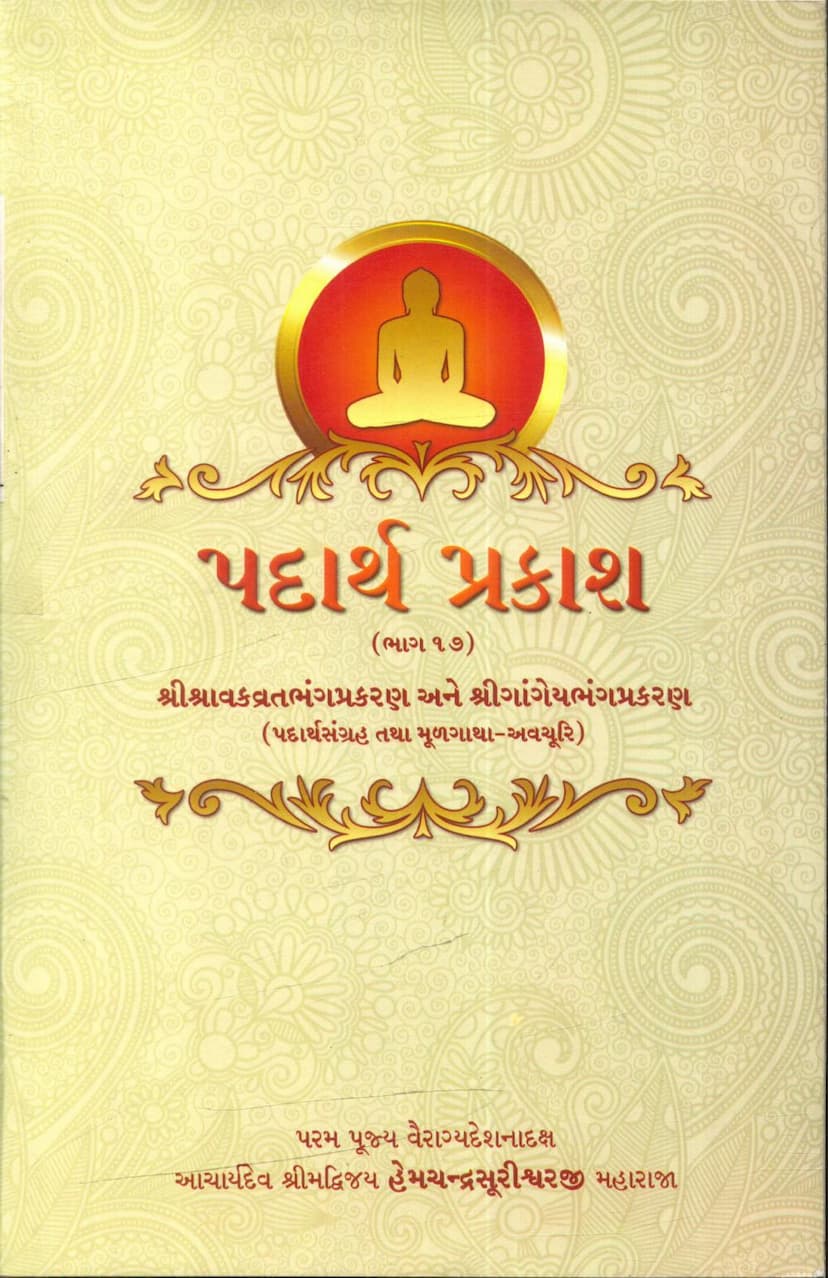Padarth Prakash Part 17
Added to library: September 2, 2025
Loading image...

Summary
The provided text is the 17th part of the "Padarth Prakash" series, compiled and edited by Acharya Shri Mad Vijay Hemchandrasuri. This volume focuses on two Jain texts: "Shri Shravak Vrat Bhang Prakaran" and "Shri Gangeya Bhang Prakaran."
Key aspects of the book:
- Content: The book presents the compilation of the "Padarth Sangrah" (collection of substances/concepts) and the original verses ("Mool Gatha") with their commentary ("Avachuri") for the aforementioned two prakarans.
- Author of Compilation: Acharya Shri Mad Vijay Hemchandrasuri has compiled this work. The publication mentions his previous works in the "Padarth Prakash" series (Parts 1-16), which covered various Jain scriptures and texts, including karmic texts, and philosophical treatises.
- Subject Matter:
- Shri Shravak Vrat Bhang Prakaran: This text, originally authored by an unknown preceptor, contains 41 Prakrit verses with an unknown author's commentary. It details the classifications of lay followers (Shravaks) based on the infractions (bhangas) of their vows. These classifications are presented in various numerical categories: 2, 8, 32, 735, and 16,808 types. The book elucidates these types and infractions, using tables and mathematical calculations for clarity. It discusses various "bhangas" (combinations of transgressions/adherence) concerning vows, including the "Shad-bhangi" (six-fold classification), 21 bhangis, 9 bhangis, 49 bhangis, and 147 bhangis, along with their subdivisions ("Khand Devakulikao") and associated "Devakulikao."
- Shri Gangeya Bhang Prakaran: This text, authored by Shri Gangeya Maharshi from the lineage of Parshvanath Bhagwan, contains 25 Prakrit verses with his own commentary. It addresses the question of whether Lord Mahavir is omniscient by analyzing the permutations of beings (from one to ten) entering various hells (from one to seven). The "Padarth Sangrah" explains this in five sections:
- The basic permutations of entering hells.
- The permutations related to the number of beings (one to ten).
- The combinations of beings entering specific hells.
- Methods for finding lost permutations ("Nasht Bhanga").
- Methods for identifying the sequence number of stated permutations ("Uddisht Bhanga").
- Purpose: The book aims to make the study of these complex concepts accessible and swift through a simple, concise, and comprehensive collection of substances. It emphasizes that studying these texts enhances mathematical understanding and concentration. The text also highlights the benefits of studying "Shri Gangeya Bhang Prakaran," as mentioned in its 24th verse, which include the destruction of severe diseases and obstacles, attainment of prosperity, divine realms, and ultimate liberation (Moksha).
- Publication: Published by Sanghavi Ambalal Ratanchand Jain Dharmik Trust.
- Acknowledgements: The publishers express gratitude to previous researchers, editors, and publishers of these texts, as well as the printers (Bharat Graphics) and the title designer (Multi Graphics). They also offer blessings for readers to gain right knowledge and achieve liberation through the study of this book.
- Illustrative Analogy: Page 8 presents an analogy of three bricklayers working on a temple. Their identical actions and wages differ in outcome based on their perspective and understanding – one sees himself as breaking stones, another as earning a livelihood, and the third as building God's temple. This highlights how knowledge and perspective change one's view of work and life, emphasizing the necessity of "Samyak Gyan" (right knowledge) for improved vision.
- Structure: The book is structured to first present the "Padarth Sangrah" for "Shri Shravak Vrat Bhang Prakaran," followed by its "Mool Gatha" and "Avachuri." Then, it follows the same pattern for "Shri Gangeya Bhang Prakaran."
In essence, "Padarth Prakash Part 17" is a scholarly compilation that makes complex Jain mathematical and philosophical concepts related to vows and karmic permutations more understandable and accessible to a wider audience. It is a testament to the detailed analytical tradition within Jainism.